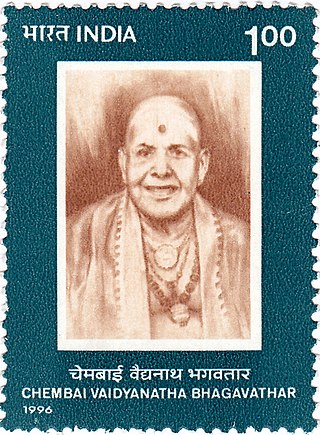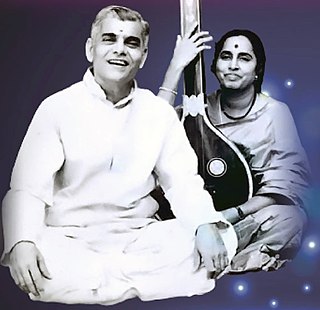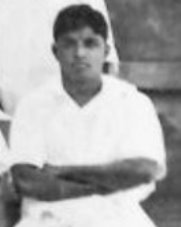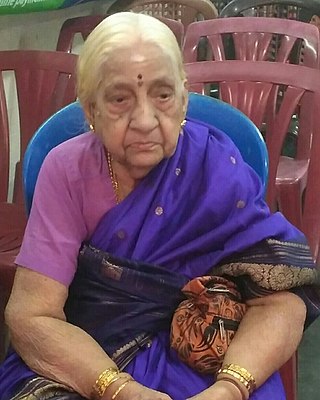
Semmangudi Radhakrishna Srinivasa Iyer was an Indian Carnatic vocalist. He was the youngest recipient of the Sangeetha Kalanidhi awarded by the Music Academy in 1947, a distinction he holds to this day as of 2024, probably the only musician to receive that honour before reaching 40. He had received many other awards as well, including Padma Bhushan and Padma Vibhushan from the Government of India, Rajyasevanirata title from Travancore's erstwhile ruling family, Sangeet Natak Academy award (1953), Isai Perarignar from Government of Tamil Nadu and Kalidas Samman from Government of Madhya Pradesh. He was affectionately addressed as "Semmangudi Maama" by his disciples. He was also considered the "Pitamaha" or the grand sire of modern Carnatic Music. He was conferred with an honorary doctorate by University of Kerala in 1979.

The mridangam is an ancient percussion instrument originating from the Indian subcontinent. It is the primary rhythmic accompaniment in a Carnatic music ensemble. In Dhrupad, a modified version, the pakhawaj, is the primary percussion instrument. A related instrument is the Kendang, played in Maritime Southeast Asia. Its a complex instrument to tune and involves a lot of mathematics to construct korvais.

Ariyakudi Ramanuja Iyengar, popularly known as Ariyakudi, was a Carnatic music vocalist, born in Ariyakudi, a town in the present-day Sivaganga district of Tamil Nadu. Ariyakudi developed a unique style of singing which came to be known as The Ariyakudi Tradition and is followed by his students. He is credited with establishing the modern katcheri (concert) traditions in Carnatic music.

Chembai Vaidyanatha Bhagavatar was an Indian Carnatic music singer from Kerala. He was born in Kozhikode, and moved to Palakkad along with him family during his childhood. He is popularly known as Chembai, or sometimes simply as Bhagavatar. Chembai was noted for his powerful voice and majestic style of singing. His first public performance was in 1904, when he was nine. A recipient of several titles and honours, he was known for his encouragement of upcoming musicians and ability to spot new talent. He was responsible for popularising compositions like Rakshamam Saranagatam and Pavana Guru, among others.

Palghat Kollengode Viswanathan Narayanaswamy, often referred to as K. V. Narayanaswamy was an Indian musician, widely considered to be among the finest Carnatic music vocalists of the 20th century. He was awarded the Madras Music Academy's Sangeetha Kalanidhi in 1986. He was described as the "Perfect Knight" of Carnatic music, a phrase from Geoffrey Chaucer, by V. K. Narayana Menon, art critic of India and recipient of the Sangeet Natak Akademi Fellowship.
Pazhani Subramania Pillai (1909–1962) was a well known Carnatic music percussionist. He, along with his contemporaries Palghat Mani Iyer and Ramanathapuram C. S. Murugabhoopathy, are revered as the "Holy Trinity of Mridanga". He was adept in playing the mridangam and kanjira. He was the sishya (disciple) of the celebrated Palani Muthaiah Pillai.

Palghat T. S. Mani Iyer (1912–1981), born Thiruvilvamala Ramaswamy was one of the leading mridangists in the field of Carnatic music. He, along with his contemporaries Palani Subramaniam Pillai and Ramanathapuram C. S. Murugabhoopathy, are revered as the "Holy Trinity of Mrudangam". Mani Iyer was the first mridangist to be awarded the Sangeetha Kalanidhi (1966) presented by the Music Academy of Madras, the Padma Bhushan (1971) and the Sangeet Natak Akademi Awards(1956) presented by the Government of India.
This is a listing of the commercially published recordings of Chembai Vaidyanatha Bhagavatar (1895–1974).
Concerts of Chembai were concerts by Chembai Vaidyanatha Bhagavatar, an Indian Carnatic music vocalist of the 20th century.
Palghat R. Raghu was a Carnatic musician and percussionist. He was awarded the Madras Music Academy's Sangeetha Kalanidhi in 2007.

Karaikudi Mani was an Indian mridangam player.

Mavelikkara Velukutty Nair was an Indian mridangam player.

Ramanathapuram C. S. Murugabhoopathy, popularly referred to as CSM, was one of the most distinguished Mridanga maestros of the 20th century. He was a contemporary of Palghat Mani Iyer (1912–1981) and Palani Subramania Pillai (1908–1962). The three legends are revered as the "Holy Trinity of Mridanga".
E. M. Subramaniam was an Indian Carnatic classical percussionist. Subramaniam was instructed in ghatam under the tutelage of his father. He has accompanied master percussionists including mridangam players such as Palghat Mani Iyer, Umayalpuram K. Sivaraman, and T. K. Murthy, and tabla players such as Alla Rakha Khan, Kishan Maharaj, and Zakir Hussain. He has been a grade A ghatam artist of All India Radio for the past 40 years. Subramaniam was awarded the title of "Kalaimamani" in 2000 and recognized with a Sangeet Natak Akademi Award in ghatam in 2011. His style of playing is compact with great tonal quality. E.M. Subramaniam has worked as a professor in Tamil Nadu Government music college (Adyar). He died on 23 April 2015.

Vellore G. Ramabhadran was a Mridangam artiste from Tamil Nadu, India. He was awarded the Madras Music Academy's Sangeetha Kalanidhi in 2004.

Parassala B. Ponnammal was an Indian Carnatic musician from the south Indian state of Kerala. She was a classical carnatic vocalist in the lineage of Semmangudi Srinivasa Iyer, Muthiah Bhagavathar, and Papanasam Sivan. She was the first woman to perform at the Navaratri Mandapam in Thiruvananthapuram as a part of the Navaratri Celebrations of the Sri Padmanabhaswamy temple in Kerala.
Nidumolu Sumathi, also known as Dandamudi Sumathi is an Indian percussionist, primarily playing the mridangam. She is married to "Mridangam Maestro" Sri Dandamudi Ram Mohan Rao. She is one of the first female mridangam players in India, and the first female Laya Vinyasam artist. Sumathi received India's fourth-highest civilian award, Padma Shri, in 2021.

Sukanya Ramgopal is an Indian carnatic musician from Tamil Nadu. She is best known as the first woman ghatam player in Carnatic music. She is also proficient in carnatic vocal, violin, mridangam and veena. She received several awards including Sangeet Natak Akademi Award, Karnataka Sangeeta Nritya Academy Award and awards from Madras Music Academy, Chennai.
Trivandrum V. Surendran is a mridangam exponent from Kerala, India. He received several awards including the Sangeet Natak Akademi Award, Kerala Sangeetha Nataka Akademi Fellowship, Kerala Sangeetha Nataka Akademi Award, and Madras Music Academy Award.












